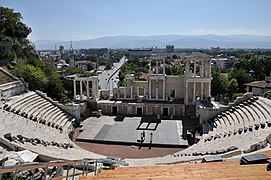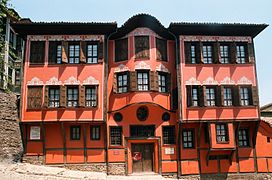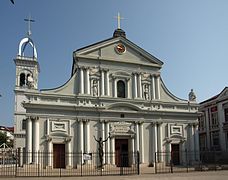![]() Click here to see the map of the area in full screen.
Click here to see the map of the area in full screen.

THE Plovdiv (Bulgarian: Пловдив, pronounced Plovdiv) is its second largest city Of Bulgaria with a population of 341,567 inhabitants.
At a glance
Plovdiv is on the banks of the river Evros, southeast of Bulgarian capital Σοφιας. The city is in the southern part of the homonymous plain, an alluvial plain, which is the western part of Ano Thracian Plain. To the northwest rises Sredna Gora, to the east the Tsirisan Hills, while the Rhodope Mountains surround the plain to the south. The city was originally developed to its south Evros and has expanded on both sides of the river for only the last 100 years. Modern Plovdiv occupies an area of 101 sq.m., less than 0.1% of its total area Of Bulgaria. This makes it the most densely populated city in the country with 3,769 inhabitants per sq.m. Inside the main town there are six hills. At the beginning of the 20th century there were seven, but one (Markovo Tepe) was leveled. Three of them are called Trilofos (Bulgarian: Трихълмие, Τριχάλμιε), the others are called Youth Hill (Bulgarian: Младежки хълм, Mladetski halm), Hill of the Liberators (Bulgarian: Хълмте, Нволти, Хвомте Danov Hallm, Danoff Hallm).
It is the administrative center of the homonymous province (Bulgarian: Пловдивска Област) and the municipalities of the City of Plovdiv, Evros and her Rodopi, which have a total population of 404,665 inhabitants in 2015. It is an important economic, transport, cultural and educational center. On September 5, 2014, it was selected as the European Capital of Culture for 2019. Its population is predominantly Bulgarian but there are also minority populations of Gypsies, Greeks, Turks, Jews and Armenians. From the beginning of the 20th century Plovdiv developed as an important industrial center. Food processing, tobacco, brewing and textiles were the main pillars of the industry. Under the communist regime, the city's economy expanded significantly and heavy industry prevailed. It also produces lead and zinc, machinery, electronics, trucks, chemicals and cosmetics. After the fall of Communism in 1987 and the collapse of its planned economy Of Bulgaria several industrial complexes were closed.
Ideal period of visit
How to get there
 By air
By air
 By train
By train
 By road
By road
Plovdiv is connected by a expressway (127 km) to Sophia.
 By boat
By boat
Orient yourself
How to move
What to see
There are many monuments preserved from antiquity, such as the ancient Roman theater, the Roman conservatory, the Roman aqueduct, the Roman Stadium, the archeological ensemble "Peace" and others.
- Regional History Museum (Plovdiv Regional History Museum), Saedinenie Square 1.
- Ethnographic Museum, 2, Dr. Chomakov. The Museum is housed in the historic residence of Argir Kuyumdzhioglu, a Greek-born Plovdiv resident and wealthy merchant who ran a commercial business in Vienna.

Roman theater

Historical Museum

Ethnographic museum
Church of Agios Konstantinos and Eleni

Saint Louis Cathedral
Entertainment
Events
Plovdiv hosts cultural events such as the International Fair, the International Theater Festival "Tent at the Crossroads" and a television festival.
Studies
- University of Plovdiv "Paisios Chilandrinos" (Plovdiv University). was founded in 1961 and consists of 9 schools. The University has about 18,000 students.
Job opportunities
What will you buy
Where are you going to eat?
Economic options
Middle class
High benefits
Where to go for coffee - drink
Where will you stay?
Economic options
- Hotel Plovdiv Guest, 20 Saborna St, ☎ 359 32 622 432, e-mail: [email protected].






